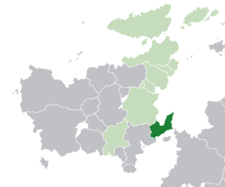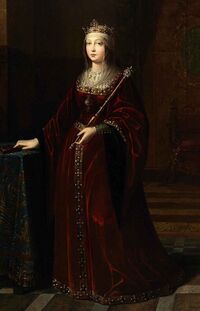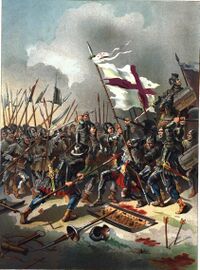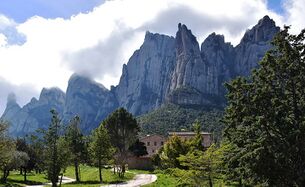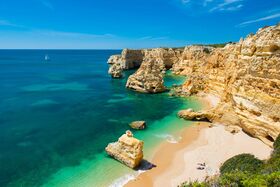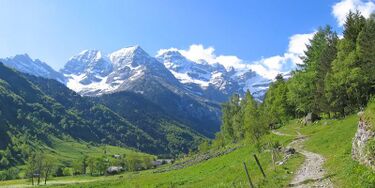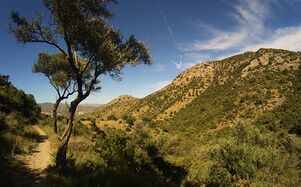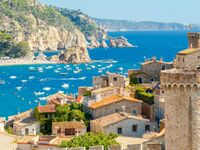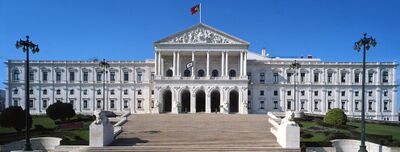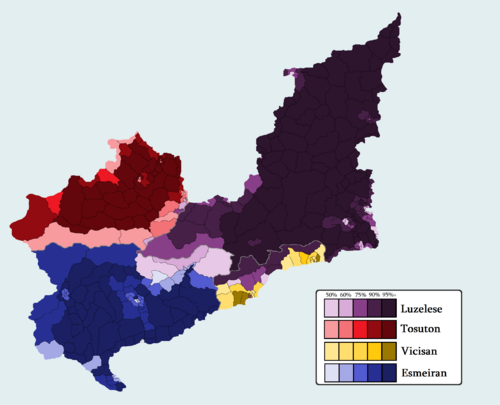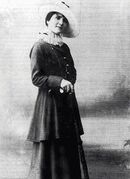Paretia: Difference between revisions
No edit summary |
No edit summary |
||
| Line 226: | Line 226: | ||
The {{wp|Head of Government}} of the country is the [[Premier]]. The Premier is appointed by the monarch after a vote of {{wp|confidence}} in the [[Câmara do Congresso]]. The Premier is either a leader of a party or the leader of a coalition that has control of most of the [[Assembleia Nacional]]. The Premier controls the [[Government of Paretia]] and usually serves a term of 3 years in office, but the country does not have term limits on the office. The current [[Premier]] of Paretia is [[Isilda Cerqueira]], she has been in office since 2020. | The {{wp|Head of Government}} of the country is the [[Premier]]. The Premier is appointed by the monarch after a vote of {{wp|confidence}} in the [[Câmara do Congresso]]. The Premier is either a leader of a party or the leader of a coalition that has control of most of the [[Assembleia Nacional]]. The Premier controls the [[Government of Paretia]] and usually serves a term of 3 years in office, but the country does not have term limits on the office. The current [[Premier]] of Paretia is [[Isilda Cerqueira]], she has been in office since 2020. | ||
[[File: | [[File:DE01766.jpg|400px|thumb|left|The [[Assembleia Nacional]] Building in [[Precea]]]] | ||
The [[Câmara do Congresso]] has a total of 360 seats who represent {{wp|electoral districts}} and are elected to each seat through a annual {{wp|General Election}} or {{wp|Snap Election}}. Each of the nations have a purportionate number of seat,s [[Luzela]] having 161, [[Esmeira]] having 96, [[Tosutonia]] having 73 and [[Vicisa]] having 30. These elections are held every three years. The country has a multi-party system. The current largest party in the [[Câmara do Congresso]] is the [[Socialistas Democratas]], however they are not part of the ruling government coalition, which is the [[Aliança Harmônica]], a far-right to centrist coalition of right leaning parties, the largest being the [[Movimento Patrono]]. | The [[Câmara do Congresso]] has a total of 360 seats who represent {{wp|electoral districts}} and are elected to each seat through a annual {{wp|General Election}} or {{wp|Snap Election}}. Each of the nations have a purportionate number of seat,s [[Luzela]] having 161, [[Esmeira]] having 96, [[Tosutonia]] having 73 and [[Vicisa]] having 30. These elections are held every three years. The country has a multi-party system. The current largest party in the [[Câmara do Congresso]] is the [[Socialistas Democratas]], however they are not part of the ruling government coalition, which is the [[Aliança Harmônica]], a far-right to centrist coalition of right leaning parties, the largest being the [[Movimento Patrono]]. | ||
Revision as of 20:57, 5 March 2021
United Kingdom of Paretia Reino Unido Da Paretia (Luzelese) Reino Unido De Paretia (Esmeiran) | |
|---|---|
| Motto: Força na Fraternidade! "Strength in Brotherhood!"
"" | |
| Anthem: Marchamos Juntos! "We March Together!" | |
| Royal Coat of Arms | |
Paretia in Euclea(Green) and the Euclean Community(Light Green). | |
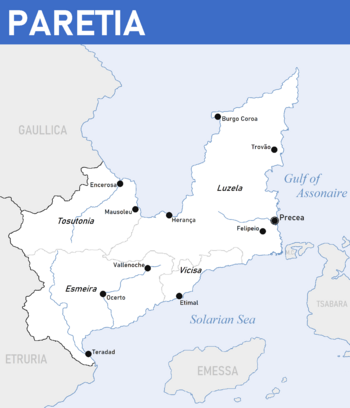 | |
| Capital and Largest City | |
| Official languages | Luzelese Tosutonian |
| Demonym(s) | Paretian |
| Government | Federal Parliamentary Constitutional Monarchy |
• King | Erasmo |
• Premier | Isilda Cerqueira |
| Legislature | Assembleia Nacional |
| Câmara do Senado | |
| Câmara do Congresso | |
| Establishment | |
| 1541 | |
| Area | |
• Total | 240,886 km2 (93,007 sq mi) |
• Water (%) | 7.02 |
| Population | |
• 2016 census | |
| GDP (PPP) | 2020 estimate |
• Total | |
• Per capita | $26,345.11 |
| GDP (nominal) | 2020 estimate |
• Total | |
• Per capita | $23,715.79 |
| Gini (2020) | 36.9 medium |
| HDI (2020) | 0.791 high |
| Currency | Euclo (EUC (€)) |
| Date format | dd.mm.yyyy |
| Driving side | right |
| Calling code | +109 |
| Internet TLD | .pa |
Paretia (Luzelese: Paretia), officially the United Kingdom of Paretia (Luzelese: Reino Unido Da Paretia; Esmeiran: Reino Unido De Paretia; Vicisan: Reino Unido De Paretia; Tosutonian: Regne Unit d'Paretya), is a Federal Parliamentary Constitutional Monarchy situated in eastern Euclea, located on the Paretian Peninsula. It is shares land borders with two nations, the northwest by Gaullica, and to the southwest by Etruria. It also shares maritime borders with three other nations, to the east by Montecara and Tsabara, and to the southeast by Emessa. Paretia has a population of 31.2 Million people. The Country is a union of four kingdoms, Esmeira, Tosutonia, and Vicisa and Luzela, the latter being the largest and most powerful kingdom of the four. Each of these kingdoms speak a separate language and have different, but still closely intertwined cultures.
The location of Paretia on the western side of Aurean Straits has made it a place of significance throughout much of human history. For much of it's earliest history, the peninsula was inhabited by Tenic cultures, the largest was known as the Eastrian culture. By the 7th century BC, the Piraeans had begun to set up colonial cities across the peninsula. These cities would eventually grow due to the trade that was constantly going through the region. Soon the Solarian Empire would conquer the peninsula, and the empire saw Paretia with high importance and began to invest heavily into the region. Cities were founded by the empire, the largest being Preceus, which today is the capitol, Precea. After the fall of the Empire, it's successor the Verliquoian Empire would take over the peninsula. During this era the Tagamic Invasions from Coius would land on the peninsula and Paretia became the focal point of the conflicts. These hordes would sack and destroy many cities in the peninsula. Eventually the horde was defeated by the Verliquoian hold on the peninsula was severely weakened. Various kingdoms and principalities would form across the peninsula, these kingdoms each had different unique languages such as Luzelese, Esmeiran, Tosutonian, and Vicisan. The most notable of these kingdoms was Luzela, located on the eastern half of the peninsula.
By the 1400's Luzela had made itself far richer and more powerful than it's neighbors. In the early 16th century, the Queen of Luzela Marta I, would lead her armies to conquer the peninsula and install puppet kingdoms ruled by the same royal house as Luzela, House Azulas. Martia I would proclaim a United Paretian Empire or the United Kingdom of Paretia. The various Kingdoms would begin to colonize in Asteria Superior and Asteria Inferior, these colonies would be ruled by the separate kingdoms and had different official languages. In 1688 King Marcellus II would establish create the first Assembleia Nacional. In the 18th century many all of the colonies would gain independence. In 1833, King Xavier IV would join a movement to create a constitution for the nation.
In 1913, the Great Collapse would destroy the economy and the government was extremely unpopular, political leader Xulio Sousa would be elected Premier and began to implement popular liberal policies to help the economy, however the pro-entente pro-functionalist monarchy ruled by Ana II would allow and support a takeover by the fascist Solarists led by Carlito Palmyro. Sousa would be sent to exile to Etruria and begin a separate government, supporters of Sousa would begin rebellions and resistance in Paretia. The Great War began with the Solarists allying with Gaullica. Eventually the Grand Alliance and the pro-Sousa rebels would defeat the Entente and the United Paretian Republic would be founded by Sousa, however he would die of age shortly after and his successors would be unable to rebuild the country. The Etrurian Revolutionary Republic would conquer Paretia in the Solarian War. The CN would eventually liberate the country. The instability and separatism after this war would lead to a coup by pro-monarchists in 1946. The monarchy and the United Kingdom was restored by this.
Paretia would join the Euclean Community alongside Amathia in 1995. Today the country is ruled by King Erasmo and the government is lead by Isilda Cerqueira, who is the head of a moderate to center-right coalition in the Assembleia Nacional. Paretia is currently member of the CN, the EC, the Aurean Forum, and the Association of Solarian Nations.
Etymology
The word "Paretia" comes from the word Parietem, the Solarian word for "Wall". The Solarians named the peninsula when they conquered it. The name derives from the original Piraean name for the peninsula, Empodio, which meant wall in Piraean. The name comes from the idea that the peninsula was a wall that divided the northern oceans to the southern oceans of Euclea. Most Solarian documents and maps labelled the peninsula as either Parietia or Parietium. Other names for the region include West Aurea and Great Luzela.
History
Prehistory
Antiquity
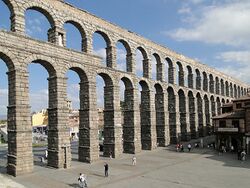
Middle Ages
Renaissance and Unification
At the Beginning of the renaissance period, art and culture began to explode from the Etrurian city-states and had spread it's influence into the peninsula. During the time, many prominent painters and other artists began to make their works in Paretia, including Esmeiran Juan Albequerquez and Luzelese Marco De Gama, both influenced by their Etrurian neighbors.
After the discovery of the Asterias by Assim Asteris in 1488, the Luzelese crown began to commission explorers expeditions to colonize on behalf of Luzela. Shortly followed by expeditions by the Esmeirans. They sent explorers such as Andres de Marchena, Tadeu do Rosário, and Duarte Bórgia, these countries would colonize what are today Marchenia, Maracao, Picasia and Belmonte. These colonies would begin to grow in size many from Luzela and Esmeira would immigrate to these colonies, the wealth of the Paretian kingdoms would begin to explode during this period. Luzela also made colonies in modern day Gulbistan, at the port city of Thyropinia.
In 1524, Queen Marta I would inherit the throne of Luzela her family, the House of Azulas, was a very rich and influencial family with that was heavily supported by the people. At the time the peninsula was divided multiple states, the two largest were Luzela and Esmeira. The Tosutonians however were divided in a lose confederation of Principalities. During this period Marta I sought to make Luzela a greater power as they had become rich from their colonies. They also were the most populous and wielded the largest naval armada of the Paretian kingdoms.
By the early 16th century, one of the regions of the peninsula would become a center of conflict between Luzela and the Tosutonians, this region was known as the Mausoterre, located between Luzela and Tosutonia it was inhabited originally by mostly Tosutonians, but Luzelese peoples moved westward and they would begin to fight over control of the region, many small kingdoms and princedoms would form in this region ruled by both peoples. Luzela at this time was only one of a few Luzelese kingdoms. These other kingdoms were separate and wanted to stay independent. Marta I would use spread the influence of the House of Azulas into these kingdoms and install her family as their rulers. Her family rule new kingdoms, and even would rule the non-Luzelese Kingdom of Visica. Marta I's justification for taking over these kingdoms was to unite the Luzelese from the Tosutonian threats in the Mausoterre.

By 1528 Marta I had a bigger agenda, which was to conquer the peninsula by using these puppet kingdoms ruled by the House of Azulas, which would become known as the Alliance of House Azulas. In March 1528 she would invade the Canonizado Order, a small Luzelese Kingdom not ruled by the Azulas House. This would be followed by the invasions of all the neighboring kingdoms of Luzela, such as Esmeira and Tosutonia. This would be the beginning of what is known as the Paretian Wars. Esmeira and Tosutonia would form an alliance against Luzela. Marta I would raise a large army and navy to at the beginning of the war and first invaded Mausoterre and the small Luzelese states. Her armies would conquer these kingdoms swiftly by 1529, but she would set her sights on Esmeira, she would first attempt to capture the city of Vallenoche, which ended up being a massive loss for her armies.
The conflict also began in the colonies as Luzelese forces in Belmonte would invade Picasia. Luzela's naval armada proved to be more powerful as they would defeat the Esmeiran fleet off the coast of Belmonte and in the Solarian Sea. In 1532, Picasia would fall as they were in a supply shortage due to a Luzelese blockade. In Luzela, Marta I's younger siblings, Infante Cássio of Herança and Infanta Alba, would prove themselves as successful military strategists and even better soldiers. Infanta Alba would be given the nickname "The Bloody Princess" by many in eastern Euclea, many accounts of extremely violent and evil acts by her such as torture and the killing of children would give her the name. In 1533, Esmeira would attempt to invade Vicisa, one of Luzela's allies, and would be crushed at the Battle of Liega. The battle would lead to a massive retreat by the Esmeiran forces and the fall of the city of Vallenoche. Up north, the Tosutonian forces were holding out. In 1535 Luzelese forces would begin to besiege the capitol of Esmeira, Ocerto, which would last for 8 months, until the city fell.
By mid 1536 Luzela had conquered most of Esmeira and their colonial possessions, New Esmeira would surrender to Luzela in September 1536. In November 1536, Esmeira, Tosutonia, and their allies would unite their armies and attack the Luzelese city of Herança in the Mausoterre. Marta I had realized their forces were outnumberred and could not reach the city in time, she instead would continue her invasion into Esmeira. She then would have her armies march across the Western Aventines into Tosutonia, and in January 1537 would send a message to the Esmeiran and Tosutonian armies. The message said that they the armies of Luzela would burn down the cities of Tosutonia and kill their families while they are busy attacking Herança. The Esmeirans and Tosutonians would then send their armies back home and meet the Luzelese at the plains of Acaton, located in eastern Tosutonia, the Esmeiran and Tosutonian armies were weary and tired as they had rushed back to Tosutonia with haste. The Luzelese forces would destroy their armies swiftly at the Battle of Acaton, which saw the fall of the kingdoms of Tosutonia and Esmeira and the Peninsula of Paretia conquered by Luzela.
For the next four years, Queen Marta I would rule Luzela as one kingdom that ruled the peninsula and would integrate the colonies into the kingdom. In order to keep unrest from occuring, in 1439 Marta would make the colonies separate entities that spoke their separate languages of Esmeiran and Portuguese language. However the language of the government business between the colonies would be Luzelese. Marta would use this system between the colonies as a way to begin setting up the governemnt in Euclea. From 1538 to 1541, Marta I would install puppet monarchies in the conquered kingdoms, all from the House of Azulas. Many of these monarchs are siblings, cousins, and children of Queen Marta I. During this period, the kingdom would grow in wealth even more now with control of the resource-rich lands in Esmeira and Tosutonia, however Marta I saw the faster growth and strength of other, unified, Euclean nations. She decided to unify the peninsula under one state that would rule all four of the kingdoms, in 1541 Marta I would declared The United Paretian Empire, which is today the United Kingdom of Paretia.

Early Modern
19th Century Paretia

Great War


Republic Period
Solarian War
Restoration of the monarch
Late 20th Century
21th Century Paretia
Geography
Paretia is approximitly 240,886 km2 in size. It is located on the promenant Paretian Peninsula which extends from eastern Euclea. The country is located between the Florian and Lumine Oceans at the Aurean Straights, which separate the country narrowly from Tsabara and the Coius continent.
The Paretia coastline is rough and jagged in most places with rocky shores cliffs spanning it's beaches. The inland regions are separated by towering mountains known as known as the Eastern Aventine Range and rolling hills in around the mountains. The nation's highest peak is Mount Avìle on the western border with Etruria, it reaches as high as 3,057 meters (10,032 ft). The longest river is the River Espiesa which flows from the northern border of Esmeira and Tosutonia and flows to it's mouth at Teradad at the southern end of the country. The flat region in Esmeira is known as the Deguita Plain.
Much of the flatlines of the country are full of rolling hills with various crops and other agricultural fields located across them. Many valleys are located in the inland of the nations as well hidden between the mountains. Much of the country is covered in a golden like soil that is known for it's tilth. The northern tip of the Paretian Peninsula is at a point known as Ponto Brilho, the eastern end of the peninsula next to Montecara is known as Ponto Continental.
The Les Fulles Mountains, Tosutonia
The Viña River Valley, Esmeira
The Costa Do Ulisto, Luzela
Mount Avìle, Esmeira
The arid Zarcuros Hills, Luzela
Climate
The Paretian Climate is mostly a mediterranean climate that varies in different parts of the country. In the center of the country as the altitude grows, the climate becomes colder and more a apline climate. Regions like Esmeira in the southern end of the country have a very diverse climate, which ranges depending on how far inland it is, from a frigid tundra at the tops of the Western Aventines, to a Humid Sub-Tropical climate in the middle, and a warm mediterranean coast. In inland Luzela, the climate becomes dry and arid areas exist due to the Western Aventines blocking rain. Tosutonia has the coldest climate among the kingdoms with a somewhat temperate climate compared to the other kingdoms and the mountains in Tosutonia are the coldest region in the country.
The average temperature of a Paretian winter depends on the location within the country. In eastern Luzela, they are usually warmer winters and snow is uncommon on the coasts, while further inland and in Tosutonia, winters can be very cold and damp, along with a very common snowfall everyone winter. The summers on the coasts of Paretia are very humid and very warm, in some areas temperatures can reach as high as temperatures that are found in Rahelia. Inland the summers are more temperate but still warm. Paretia gets some of the most sunlight in Euclea and in some years has experienced droughts in regions like Luzela, Vicisa, and southern Esmeira.
The weather of Paretia usually has normal thunderstorms in warmer times and winter storms when it is cold. Paretia rarely experiences extreme blizzards during the winter months. The country can experience tropical storms during the summer months, although a powerful tropical cyclone is rare.
Flora
Fauna
Government and Politics
The government of Paretia is a Federal Parliamentary Constitutional Monarchy in which the Monarch is the Head of State and appoints a Premier to be the Head of government. The Constitution of The United Kingdom of Paretia, adopted by the country in 1833, is the document that sets up the rules, regulations, and framework of the government. The current Monarch of Paretia is King Erasmo, who has ruled since he was given the throne in 1980. The current heir apparent of the monarchy is his daughter, Princess Miriam.
Government
King of Paretia
Premier of Paretia
The Legislature of Paretia is a set up in a bicameral system and is known as the Assembleia Nacional. There are two legislative chambers, the lower chamber is known as the Câmara do Congresso, and the upper chamber is known as the Câmara do Senado. The last chamber is the Coroa, which is where the monarch presides. In order for a bill to be made into law, it needs to pass a vote in both the Câmara do Senado and Câmara do Congresso, and then get approval from the Coroa to which then it becomes law. The National Assembly Building is located in the center of Precea and it houses both legislative chambers.
The Head of Government of the country is the Premier. The Premier is appointed by the monarch after a vote of confidence in the Câmara do Congresso. The Premier is either a leader of a party or the leader of a coalition that has control of most of the Assembleia Nacional. The Premier controls the Government of Paretia and usually serves a term of 3 years in office, but the country does not have term limits on the office. The current Premier of Paretia is Isilda Cerqueira, she has been in office since 2020.
The Câmara do Congresso has a total of 360 seats who represent electoral districts and are elected to each seat through a annual General Election or Snap Election. Each of the nations have a purportionate number of seat,s Luzela having 161, Esmeira having 96, Tosutonia having 73 and Vicisa having 30. These elections are held every three years. The country has a multi-party system. The current largest party in the Câmara do Congresso is the Socialistas Democratas, however they are not part of the ruling government coalition, which is the Aliança Harmônica, a far-right to centrist coalition of right leaning parties, the largest being the Movimento Patrono.
The Câmara do Senado is the upper house and has a total of 130 seats. Each of the representing the various counties of the country. Each of the four nations have 30 representatives each. They are elected through General Election or Snap Election which are held every three years. They use a multi-party system and the largest party is the Conservadores, who lead the Aliança Harmônica coalition. This chamber is also where the Premier and Monarch resides when called to the legislature for various meetings and deals.
Political parties
Law and Judiciary
Demographics
Ethnic
Languages
Religion
Subdivisions
Cities
Culture
Festivals and Holidays
Art
Clothing
Architecture
Music
Cuisine
Media
Literature
Sports




